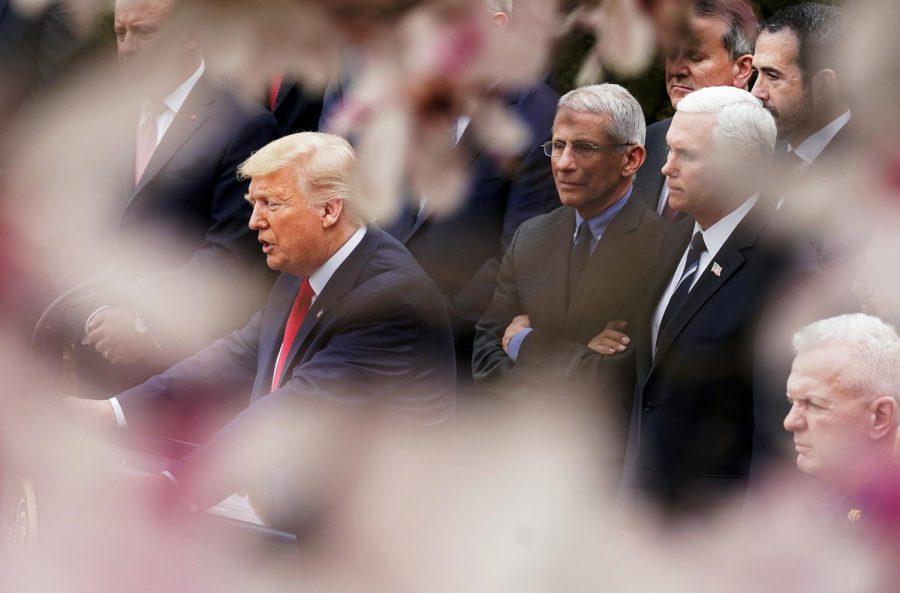Kevin Lamarque Credit: Reuters
The fog that looms over the United Sates and our pandemic response to date.
Hubris: The Fatal Flaw in America’s Initial Pandemic Response
Throughout history, individuals and communities have failed to adequately address a severe situation – and so have faced dire consequences. When faced with warnings, even those from highly qualified sources, we continue to fail to properly respond. From the American meteorologists’ lacking response to the warnings about the Galveston hurricane in 1900 to the worldwide inaction on the climate crisis, humanity seems unwilling to accept, recognize, and respond to the very real threats around us. Often we are unwilling to trust conclusions or warnings if they are not our own. It is not necessarily bad to be wary of new information, but it is when (as in these cases) this information has been put forth by qualified and accredited sources and we still do not believe it that it becomes a more serious problem.
Unfortunately, today is no different. Last fall, the results of a pandemic simulation (known as “Crimson Contagion”) done by US government agencies were published and they had some major warnings about the US’ potential to respond to a major health crisis. The report found that social distancing would be essential, there would be shortages of essential medical supplies, and generally “drove home just how underfunded, underprepared and uncoordinated the federal government would be for a life-or-death battle with a virus for which no treatment existed” according to the New York Times. However, when the findings were reported by their own administration’s simulation, the Trump administration did nothing to remedy these issues. Congress was briefed in December, but it wasn’t until last week that these issues, especially the looming shortage of medical supplies, became an urgent point of debate on Capitol Hill. The fact that government leaders initially disregarded this important information is an unbelievable mistake that could cost thousands of American lives.
This, sadly, was not the only major blunder made in the early days of Coronavirus. As warnings and increasing reports of cases trickled in from overseas, US intelligence agencies briefed the president and other government officials on the serious nature of the Coronavirus. This was back in January when the virus had not yet become a serious problem in the US. Measures could have been put into place in order to prepare the country and protect American citizens for the probable spread of the pandemic. However, no major action was taken. Officials close to the president told the Washington Post because he didn’t think that the virus was occurring extensively within the US. This attitude trickled down into other federal agencies. As Dr. Ashish K. Jha, director of Harvard’s Global Health Institute, explains “There were many, many opportunities not to end up where we are. Basically, they took this as business as usual. … And that’s because the messaging from the White House was ‘this is not a big deal, this is no worse than the flu.’ So that message basically created no sense of urgency within the FDA or the CDC to fix it.” It is plain to see that prideful inaction from the very top of the US government severely limited the US’ pandemic preparation and response.
It’s not only the government that has fallen victim to excessive pride, self-confidence, and a dangerous sense of invincibility. In the early days of the outbreak, even after the US government, the World Health Organization, United Nations, hospitals, doctors, and many other nations urged citizens to social distance in order to “flatten the curve” and slow the spread of the outbreak, Americans were still unnecessarily leaving the house, interacting with large groups of other people, and were not maintaining the CDC’s recommended 6 feet of distance. Initial information about the virus reported that young people were less likely to die from the virus and that its impact on their health would be less severe. This seemed to fuel a sense of invincibility among many young adults and teens who continued to go out to bars, eat at restaurants, and attempt to continue with their spring break plans. Their actions threatened not only their own health, but the health of those around them, especially people who are at risk due to pre-existing medical conditions. It’s not to say that young people were the only ones not adhering to social distancing, certainly far too many others of all ages also were not social distancing, but young people did make up a large portion of those who initially were not social distancing specifically because of the information they receive that fueled their own belief that they would not get sick and/or were not in danger.
A few weeks into the Coronavirus pandemic in the United States and it seems as if government officials and everyday citizens are finally beginning to heed the warnings that they’ve been hearing all along. Cities and states are going into lockdown and closing nonessential businesses, Congress passed a stimulus bill to help both the economy and the American people in this time of crisis and more and more people are social distancing. Will it be enough? Only time will tell how long this pandemic will last and whether our current responses will be strong enough to overcome the cost of our initial hubris.
Sources
https://www.nytimes.com/2020/03/19/us/politics/trump-coronavirus-outbreak.html
https://apnews.com/c335958b1f8f6a37b19b421bc7759722
https://www.cnn.com/2020/03/20/politics/us-intelligence-reports-trump-coronavirus/index.html

Heather Richmond • Mar 30, 2020 at 6:22 pm
I am really impressed with the quality of the writing and research. Keep up the good work!